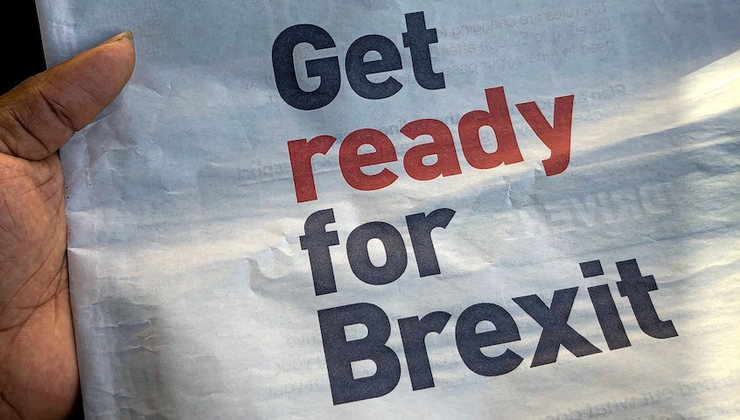- English
- Italiano
- Español
- Français
The prospects for an explosive move in the GBP and UK assets

Certainly before the transition period, trading Brexit was incredibly frustrating. Although, the good news for traders was that Brexit headlines were largely idiosyncratic to UK assets, with some sensitivity in the EUR. So, if this was all too much you could avoid it fairly easily in alternative foreign markets.
If you chose to trade the GBP and if you knew you were trading headlines, many would throw up false signals and just lead to twists within twists in a very drawn-out saga. Very little politically was solved until the last minute and subsequently volatility was elevated relative to other G10 FX pairs, which meant traders had to keep position sizing to a minimum as the risk they took in a position increased.
With implied volatility moving we saw traders time in the market reduced and the GBP exposures were seldom held when a trader couldn’t be in front of the screens.
Are we set for a repeat of these conditions?
It certainly seems unlikely and a deal is the clear consensus view, although the risk of moving past 31 December and the end of the transition phase without a deal can’t be ruled out.
The options market always gives solid insight into semantics and helps us quantify expected movement for a specific point in time. Looking at GBPUSD 1-week implied volatility (vols) it currently sits at 10% and eyeing a move lower into 8%, with 1-month vols at 10.43%. For context, the options market sees a move of 150 pips and 328-pips over a 1-week and 1-month period respectively (higher or lower). This doesn’t signal a market sensing an impending explosive move.
Positioning hardly reeks of concern to hold GBP exposures and we can see both leveraged funds and asset managers running very neutral GBP futures positions, if we look at the weekly CFTC report. Our own client flow has been incredibly two-way (i.e. long and short) of late, perhaps mirroring that of the institutional world.
The lack of implied vol and robust performance of the GBP on a broad basis suggests the market sees the risk of no-deal as a low probability. Rightly so, in the market’s eyes passing 31 December without a deal would constitute an error on behalf of Chief negotiator, David Frost and Boris Johnson. If we take the 2 November swing low of 1.2855 as a key downside target on heightened signs of no deal, at this juncture the market places a 16.3% chance of this level being breached in the coming month and 19.2% by 1 January.
Some participants will clearly believe the market is under-pricing the risk of a downside move in GBPUSD. However, unless we see equity markets roll over and head sharply lower, with the VIX pushing back towards 30% then the USD is going to find few friends in this positive backdrop. This will play into GBPUSD support. Perhaps EURGBP is the cleaner play here, but again there is no worry GBP with price printing a series of lower highs and where a breakthrough 0.8866 would be powerful.
Interestingly, the options market places a 32.8% probability of GBPUSD pushing above 1.3400 and a re-test of the September highs in the coming month and that feels like the higher risk.
In the near-term, there are still clear uncertainties on reconciling differences around EU access to UK fishing waters, the ongoing governance of a deal (and the dispute resolution) and a “level playing field” on aspects like workers’ rights, state aid, and environment.
Thursday’s EU 27 leaders meeting looms large
While we may hear of an appetite for a deal, it seems unlikely that this will be the forum to announce something tangible. While officials have commented on deadlines, none are legally binding and we really need to consider the absolute latest a deal can be forged.
Should an agreement be found which is certainly the conventional wisdom, it takes some 21 days for it to be debated and ratified in both UK and EU courts. In theory, this means the latest we can wait for some sort of free trade deal is the end of November and even then, there's still no guarantees it will pass respective parliaments. This is when GBP volatility will come alive and GBP will see far more extreme and erratic movement.
There has been some speculation that we could see an emergency European Parliament meeting being called in late December, which may get greater attention if we haven’t seen an agreement by the end of November.
Of course, this time may be different and we may not wait until the very last minute for a deal. We may hear of an agreement in the upcoming weekend or early next week. What’s clear though is either the market doesn’t see the talks as a major volatility driver or that the effects of an agreement may be short-lived, before we re-focus on COVID-19 trends, a vaccine and reflation into 2021. What seems consistent is that few are positioned for no-deal and are fully on board with a deal at some stage.
I personally favour the GBP upside, as I do sit in the camp that a deal will be found. However, the closer we get to the end of November without a deal the more nervous the market will get.
Related articles
Ready to trade?
It's quick and easy to get started. Apply in minutes with our simple application process.
The material provided here has not been prepared in accordance with legal requirements designed to promote the independence of investment research and as such is considered to be a marketing communication. Whilst it is not subject to any prohibition on dealing ahead of the dissemination of investment research we will not seek to take any advantage before providing it to our clients.
Pepperstone doesn’t represent that the material provided here is accurate, current or complete, and therefore shouldn’t be relied upon as such. The information, whether from a third party or not, isn’t to be considered as a recommendation; or an offer to buy or sell; or the solicitation of an offer to buy or sell any security, financial product or instrument; or to participate in any particular trading strategy. It does not take into account readers’ financial situation or investment objectives. We advise any readers of this content to seek their own advice. Without the approval of Pepperstone, reproduction or redistribution of this information isn’t permitted.

